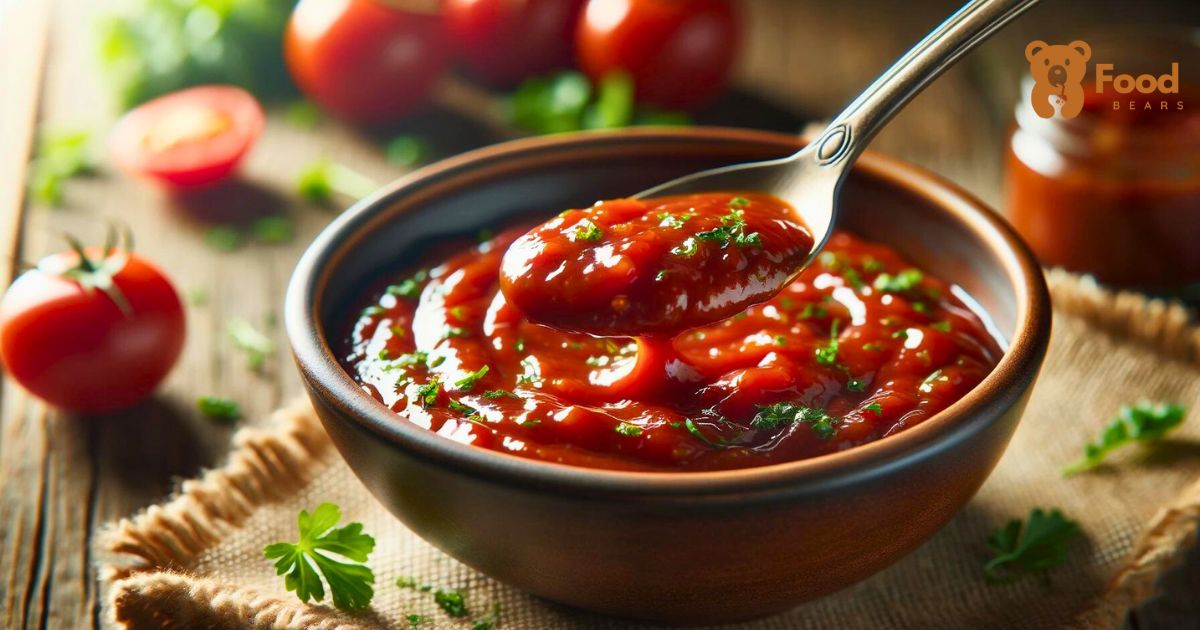When you feast on a beautifully crafted dish, doesn’t it taste even better? Visual appeal in food doesn’t just catch your eye.
It plays a crucial role in how delicious a meal tastes. That first impression can turn a simple meal into a memorable dining experience.
Today, we’re zeroing in on a critical player in the pizza world: the sauce. It’s not just a base. It’s the heart of pizza’s vibrant look and rich flavors.
Imagine the glossy spread of a rich red sauce, bright and inviting, making each slice irresistible. That’s the magic we aim to enhance.
Let’s dive into the colorful world of pizza sauce and discover how to make every dollop count for taste and aesthetics!
1. Choosing the Right Tomatoes
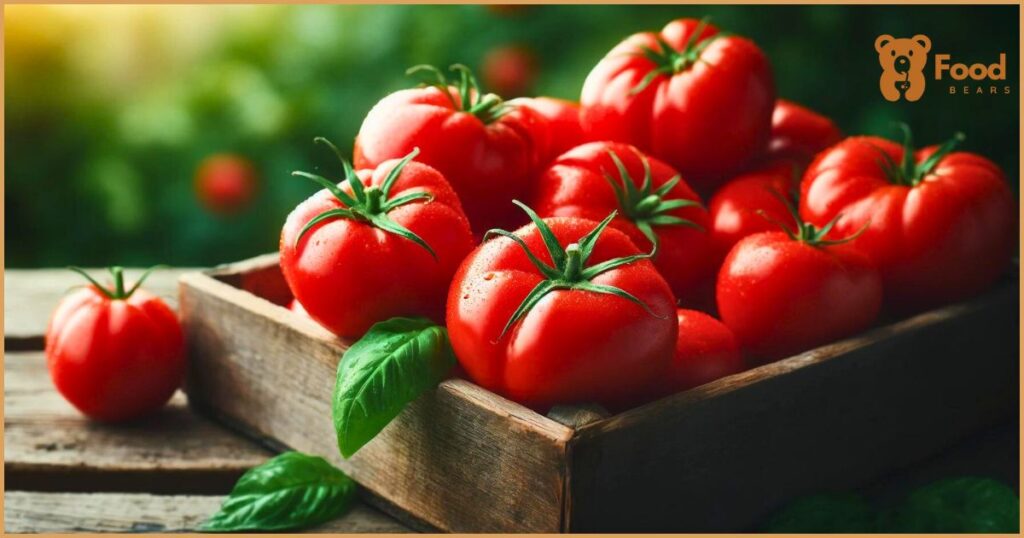
The right tomatoes can make all the difference in your pizza sauce. Not only do they affect the color, making it profoundly red and inviting.
But they also influence the overall flavor, the foundation of your pizza’s taste. A vibrant, well-chosen tomato enhances every bite with its freshness and depth.
San Marzano and Roma tomatoes are top choices for crafting that perfect sauce. San Marzanos, known for their sweet flavor and low acidity, create a balanced and rich sauce.
Their bright red color contributes beautifully to the aesthetic appeal of your sauce. Roma tomatoes, slightly plumper and equally vibrant, are prized for their dense, meaty texture, making for a thicker, heartier sauce.
When selecting tomatoes, look for ones that are richly colored and firm, with a smooth skin. This not only ensures a visually appealing sauce.
But also guarantees that the flavor is at its peak. Remember, the best tomatoes for pizza sauce are the ones that make your sauce look as good as it tastes—bright, fresh, and utterly delicious.
2. Achieving the Perfect Texture
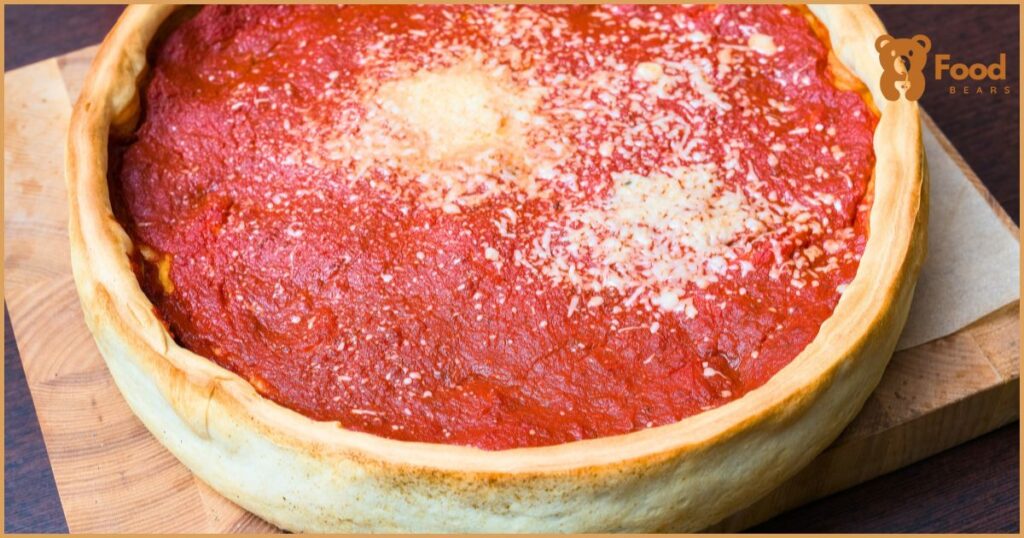
The texture of your pizza sauce can transform the eating experience. The ideal texture? Smooth yet chunky. This balance allows the sauce to spread evenly while providing pleasant bits of tomato to chew on, which enriches every bite.
A sauce that’s too smooth might be mistaken for ketchup, and one too chunky may not spread well, leading to uneven flavors across your pizza.
How to texture pizza sauce effectively involves a couple of crucial methods:
- Using a food mill: A food mill is perfect for achieving a sauce that’s not overly pureed. It helps remove seeds and skins, ensuring smoothness, and leaves behind a pleasing texture. You can control how much the tomatoes are broken down, allowing for just the right amount of chunkiness.
- Hand-crushing: Hand-crushing your tomatoes is the way to go for those who love a more rustic feel. Squeeze the tomatoes by hand, breaking them into small, irregular pieces. This method gives you complete control over the texture and produces a sauce with character and body.
Both techniques ensure that your sauce holds onto the pizza nicely and melds well with other toppings. Also provides a delightful eating experience with every slice.
Achieving the perfect texture enhances the tactile aspect of eating pizza and boosts the visual appeal, making the pizza as joyous as it is to eat.
3. Garnishing with Fresh Herbs
Adding fresh herbs like basil or oregano to your pizza sauce is not just about flavor; it’s a visual celebration.
The vibrant greens of the herbs provide a striking contrast against the rich red of the sauce, making your pizza look as fresh as it tastes.
This pop of color enhances the visual appeal and can make your dish look more delicious and inviting.
Using fresh herbs in pizza sauce effectively requires timing and technique:
- When to add: To maximize their aromatic impact and maintain their color, add fresh herbs towards the end of cooking the sauce. This preserves their essential oils and vibrant color, often lost if cooked too long.
- How to add: Mix the herbs to release their flavors and sprinkle them evenly across the sauce. For basil, you might consider adding whole leaves directly to the sauce after it has been spread on your pizza base. This infuses flavor and leaves a visually striking leaf on each slice.
Remember, the key is to use the herbs as a flavor enhancer and an integral part of the pizza’s presentation.
Using fresh herbs elevates the aesthetic dimension of your pizza, making each slice a miniature work of art that’s as beautiful as it is delicious.
4. Managing Sauce Consistency
Achieving the perfect pizza sauce consistency is crucial; it affects how the sauce melds with the dough and interacts with other toppings.
A sauce that’s too watery can seep into the dough, making your pizza soggy and less appealing. Conversely, a too thick sauce might not spread evenly, resulting in dry spots and an overpowering taste in others.
To find that sweet spot:
- Simmering: This is your go-to technique to reduce excess water and thicken a watery sauce. Gently simmer the sauce on low heat, allowing the moisture to evaporate slowly. This method enhances the sauce’s flavors while thickening it to consistency. Keep stirring occasionally to ensure even cooking and prevent burning.
- Adjustment in small increments: If your sauce has become too thick, you can carefully adjust it by adding a little water or tomato juice. Do this slowly, mixing thoroughly until you reach the desired consistency. This way, you control the texture without diluting the flavor too much.
By managing your sauce’s consistency, you ensure it complements rather than overwhelms the pizza.
It should lightly coat the back of a spoon, a sign that it’s neither too thick nor too thin but just right for layering on your dough.
With the right consistency, your sauce will look good and enhance the overall eating experience, making each pizza slice perfect.
5. Enhancing Gloss with Olive Oil
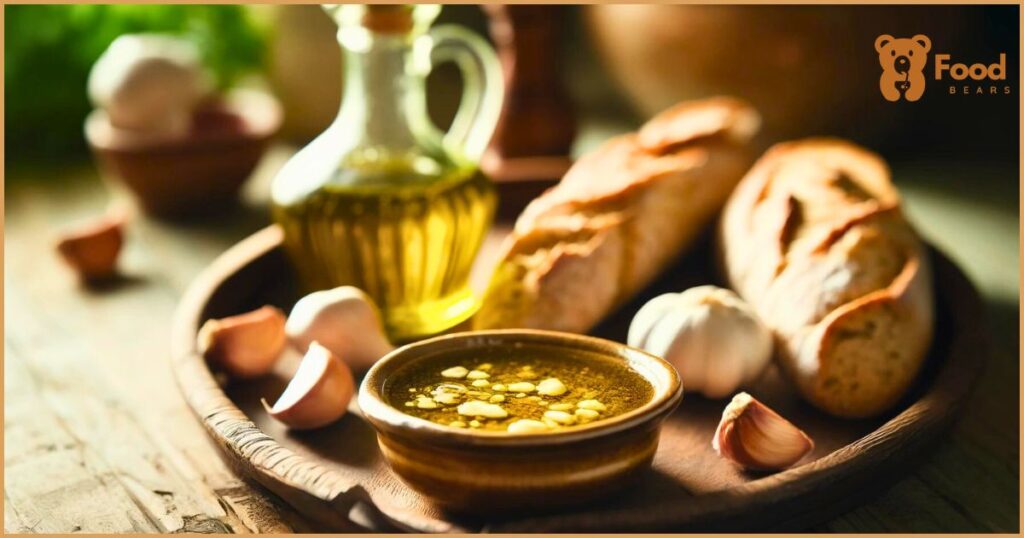
A drizzle of olive oil can transform your pizza sauce from simply tasty to visually stunning. Olive oil for pizza sauce sheen adds a rich flavor and imparts a beautiful glossy finish. It makes the sauce look more appetizing and professional.
Here’s how olive oil elevates the sauce:
- Visual appeal: The natural oils add a subtle shine to the sauce, which catches the light and makes the surface glisten. This sheen is appealing, giving the impression of a richer, more decadent topping.
- Flavor enhancement: Olive oil complements the natural flavors of the tomatoes and herbs, rounding out the overall taste profile of the sauce.
Choosing the right olive oil:
- Extra virgin olive oil is your best choice for adding to pizza sauce. It’s made from pure, cold-pressed olives, offering a superior taste and higher quality. Its robust flavors include fruity, bitter, and spicy notes, which can significantly enhance the flavor of your pizza sauce.
- For a lighter touch, you might opt for a lighter olive oil, which still provides a glossy sheen without overpowering the sauce’s flavor.
A final swirl of olive oil before serving can make your pizza sauce pop with color and flavor, adding that perfect finishing touch to your culinary creation.
This simple step boosts the aesthetic appeal and enriches the sensory experience of enjoying your pizza.
6. Balancing Acidity with Sugar
A pinch of sugar can work wonders in your pizza sauce, not just by enhancing its flavor but also by improving its color.
When you focus on enhancing pizza sauce color with sugar, you tap into a simple yet effective culinary technique that balances acidity and boosts visual appeal.
Why sugar matters:
- Taste Balance: Tomatoes naturally contain acids that can sometimes overpower the sauce, making it too sharp or tangy. Adding a little sugar neutralizes some of this acidity, resulting in a smoother and more balanced flavor.
- Color Enhancement: Sugar can subtly brighten the red hue of your sauce, making it look more vibrant and enticing. This happens because sugar helps caramelize the natural sugars in the tomatoes when cooked, deepening the color and adding a rich gloss.
How to effectively use sugar:
- Start with a small amount, about a teaspoon for a standard batch of sauce, and taste as you go. You can always add more, but it’s crucial not to overdo it, as too much sugar can make your sauce taste sweet.
- Add the sugar early in the cooking process to allow it to dissolve completely, and blend with the tomatoes and other ingredients.
Using sugar to balance the acidity in your pizza sauce ensures that each spoonful is delicious and visually appealing.
This simple tweak in your sauce preparation can make a significant difference in your homemade pizza’s aesthetics and taste.
7. Using Fresh Ingredients
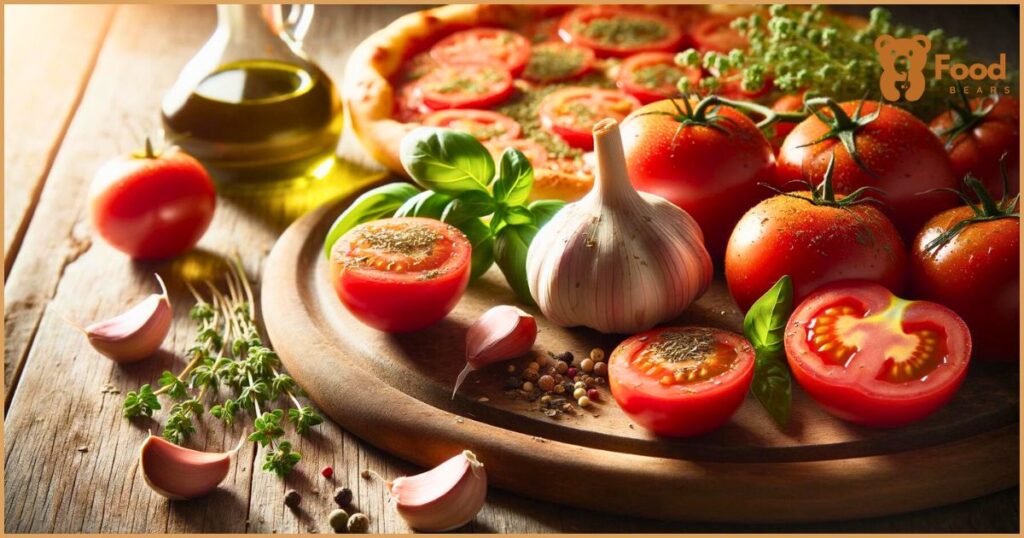
The choice between fresh and dried ingredients can drastically alter the flavor and appearance of your pizza sauce.
When discussing the benefits of fresh ingredients in pizza sauce, we highlight how these choices contribute to a superior, more vibrant dish.
Impact on Flavor and Appearance:
- Flavor: Fresh ingredients, such as tomatoes, garlic, and herbs, contain natural oils and juices rich in flavor. These elements are often diminished or lost in their dried counterparts. Fresh garlic, for instance, imparts a sharp, unmistakable taste that powdered garlic can’t match.
- Appearance: Fresh tomatoes and herbs bring a vivid color palette to your sauce. The bright red of fresh tomatoes and the lush green of fresh basil or oregano make the sauce more visually appealing and delicious.
Suggested Fresh Ingredients:
- Tomatoes: Opt for ripe, fresh tomatoes like San Marzano or Roma for their bright color and full-bodied flavor.
- Garlic: Use fresh garlic cloves minced finely to infuse the sauce with a robust and aromatic flavor.
- Herbs: Fresh basil, oregano, and parsley add depth to the flavor and introduce a splash of color that dried herbs cannot offer.
- Onions: Chopped fresh onions provide a sweet, caramelized texture when sautéed, enhancing the sauce’s flavor and texture.
Incorporating fresh ingredients into your pizza sauce elevates its taste profile and visual appeal. This makes the sauce more delightful to the senses and turns your pizza into a feast for the eyes.
Remember, the freshness of your ingredients is crucial in creating a sauce that’s as beautiful and delicious to eat.
8. Application Techniques on Pizza
Applying pizza sauce correctly is as important as the sauce when crafting the perfect pizza. Mastering how to use pizza sauce aesthetically ensures that each slice is as visually appealing as delicious.
Best Practices for Application:
- Use the Back of a Spoon: Start by placing a dollop of sauce in the center of your pizza dough. Then, using the back of a spoon, gently spread the sauce outward in a spiral motion. This technique helps control the amount of sauce and ensures an even distribution.
- Leave a Border: It’s crucial to leave a small border around the edge of the pizza dough unsauced. This not only helps create a crust that can rise and become crispy but also adds a professional touch to the aesthetics of your pizza. The contrast between the sauced center and the bare crust accentuates the sauce’s richness.
Importance of Even Spreading:
- Even Cooking: Sauce that’s evenly spread helps the pizza cook uniformly, preventing overly dry or soggy areas.
- Flavor in Every Bite: Consistent sauce application ensures that each bite is flavorful. This balance is critical to a satisfying pizza experience.
These techniques are not just about beauty; they’re about crafting a pizza that looks as good as it tastes.
By focusing on even spreading and aesthetic borders, you elevate the overall presentation of your pizza.
9. Storing Sauce for Freshness

Proper storage of pizza sauce is critical to maintaining its color, freshness, and flavor until the next delicious pizza-making session.
Understanding storing pizza sauce for freshness can make the difference between a just-okay sauce and one that’s vibrant and tasty every time.
Tips for Proper Storage:
- Use Air-Tight Containers: Transfer your pizza sauce into air-tight containers to minimize exposure to air, which can degrade the quality and lead to spoilage. Glass jars or plastic containers with tight-sealing lids are ideal choices.
- Refrigerate or Freeze: Keep your sauce in the refrigerator for short-term storage, which can last up to a week. For more extended storage, freezing is an effective option. Frozen pizza sauce can last several months without losing much of its quality.
Advice on Using Olive Oil Topping:
- Create a Seal: Before sealing your sauce container, consider drizzling a thin layer of olive oil over the surface of the sauce. This oil layer acts as a barrier, reducing air contact and helping preserve the sauce’s vibrant color and flavor.
- Flavor Preservation: This method extends the sauce’s shelf life and adds an extra layer of flavor, enhancing the overall taste when it’s time to use the sauce again.
By following these storage tips, you ensure that your pizza sauce remains as fresh and appealing as the day it was made. Keeping your sauce in perfect condition means you’re always ready to whip up a visually stunning and delicious pizza immediately.
10. Serving with Aesthetic in Mind
Serving your pizza with an eye for aesthetics can elevate the entire dining experience. By serving pizza for visual appeal, you ensure your dish tastes amazing and looks stunning.
Suggestions for Plate Selection:
- Contrasting Colors: Choose plates that contrast the vibrant red of your pizza sauce. White plates are a classic choice, making the colors of your pizza pop. For a more rustic feel, consider wooden boards or stoneware that highlight the artisanal nature of your pizza.
- Size and Shape: Opt for plates that comfortably accommodate the size of your pizza slices. A plate that is too small can make the presentation look cramped, while a larger plate can frame the pizza beautifully, giving it space to shine.
Tips for Presenting the Pizza:
- Neat Slices: Slice the pizza cleanly with a sharp cutter to ensure each piece looks tidy and appealing. Ragged edges can detract from the overall presentation.
- Arranging Slices: Fan the slices slightly on the plate or board so each slice is visible. This looks attractive and makes it easy for guests to pick up a slice.
- Garnish Thoughtfully: Add a final touch by garnishing with fresh basil leaves or a sprinkle of Parmesan cheese. This enhances the flavor and adds a touch of elegance to the presentation.
By focusing on these presentation tips, you ensure that your pizza is a delight to the taste buds and a feast for the eyes. Every element, from the choice of plate to the arrangement of slices, contributes to a dining experience that’s both visually appealing and delicious.
Conclusion
Crafting a visually appealing pizza sauce isn’t just about impressing the eyes. It’s about enhancing the entire dining experience.
The aesthetics of your pizza sauce can make your dish more inviting and delicious, transforming a simple meal into something special.
From choosing the right tomatoes, achieving the perfect texture, adding fresh herbs, and managing sauce consistency. Every step contributes to a sauce that’s as beautiful as flavorful.
Don’t be afraid to experiment with different techniques and ingredients. Try new types of tomatoes, play with textures, or garnish with various fresh herbs. Each tweak can bring a new dimension to your pizza sauce, making it uniquely yours.
We’d love to hear from you! Have you tried any of these tips? Please share your results in the comments below, or tell us which tip is your favorite. Let’s create and enjoy beautiful, delicious pizzas together!

Ella Foster, co-founder of FoodBears.com, is a skilled writer whose love for cooking fuels her creative work. Her passion for experimenting in the kitchen brings authentic flavor and culinary inspiration to every piece she crafts for the platform.
